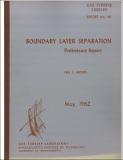| dc.contributor.author | Moses, Hal Lynwood | en_US |
| dc.contributor.other | Massachusetts Institute of Technology. Gas Turbine Laboratory | en_US |
| dc.date.accessioned | 2016-10-06T21:22:08Z | |
| dc.date.available | 2016-10-06T21:22:08Z | |
| dc.date.issued | 1962 | en_US |
| dc.identifier.uri | http://hdl.handle.net/1721.1/104714 | |
| dc.description | May 1962 | en_US |
| dc.description | Includes bibliographical references | en_US |
| dc.description | Preliminary report | en_US |
| dc.description.abstract | The phenomenon of incompressible boundary layer separation and the existing methods of predicting it are discussed. The failure of these theories in many cases clearly indicates a need for further investigation. A program is proposed that, it is hoped, will improve the present situation. The study is directed primarily at turbulent flow, but the laminar case is treated as well. A theoretical method is presented which involves the ability of the boundary layer to transfer momentum to the fluid near the wall by shear stress. The apparatus, which has already been built for the experimental investigation, is described. Due to its flexibility, the apparatus should prove valuable in comparing and improving methods of predicting separation. | en_US |
| dc.description.sponsorship | Under the Sponsorship of: Office of Naval Research | en_US |
| dc.format.extent | [31] pages (some unnumbered) | en_US |
| dc.publisher | Cambridge, Mass. : Gas Turbine Laboratory, Massachusetts Institute of Technology, [1962] | en_US |
| dc.relation.ispartofseries | GTL report #68 | en_US |
| dc.subject.lcc | TJ778.M41 G24 no.68 | en_US |
| dc.subject.lcsh | Boundary layer | en_US |
| dc.title | Boundary layer separation ; preliminary report | en_US |
| dc.type | Technical Report | en_US |
| dc.identifier.oclc | 14200080 | en_US |
